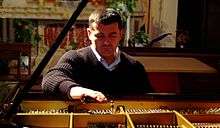Luigi Borgato
Luigi Borgato (Gallarate, * February 21, 1963) is an Italian piano-maker of handcrafted concert-grand pianos.

Vicentine piano-maker, he innovated ameliorating some technical aspects in piano making, patenting them. In his capacity as master piano-maker is invited by Italian as well as foreign institutions to run courses on piano construction and technology.[1]
Profile
In 1991, at the age of 28, he presented his first completely handmade concert-grand piano at the European congress ‘Europiano’.[2]
Luigi Borgato personally selects the wood and chooses all the materials and components for the construction of his pianos.,.[3][4] Luigi Borgato is a piano tuner: he personally tunes each of his instruments for world famous pianists' recordings and concerts as Radu Lupu,[5] András Schiff, Vladimir Ashkenazy,[6] Rosalyn Tureck, Lazar Berman, Maria João Pires, Ingolf Wunder, Roberto Prosseda,[7] Martin Berkofsky, Antonio Ballista, Bruno Canino, Michele Campanella, Roberto Giordano, Massimiliano Ferrati, Semion Balshem, Jean Guillou, Charlemagne Palestine, Cameron Carpenter, Johannes Skudlik, Giorgio Carnini...
Patents
Luigi Borgato registered some patents. A first one, in 1991, providing the upper register of the keyboard with four strings struck per note in the 44 keys of the upper register, and innovative iron frame.
In 2000, he registered a second patent: inspired by compositions written for piano with pedalboard he designed and built a new instrument, the Doppio Borgato, the first double concert-grand piano with pedalboard constructed in modern times.[8][9][10]
Notes
- Le Progrès, 6 May 1996
- Günther Weingärtner, Europiano, April–June 1992 p.53-56
- Pierantonio Barizza intervista Luigi Borgato (Pierantonio Barizza interviews Luigi Borgato)
- Galileo Rivista di informazione, attualità e cultura degli Ingegneri di Padova (Paduan Engineer’s information, actuality and cultural magazine), n.172 November–December 2005, p.14-17
- Alessandro Cannavò, Amadeus, April 1997, p.52-53-54
- Il Giornale di Vicenza 19 November 2003
- Roberto Codazzi, in Musica, Zecchini Editions, April 2005
- Brian T.Majeski, The Music Trades, November 2000, p.86
- Pianist Magazine, April May 2006 UK
- Honka Verdurmen, Piano Wereld, Holland, August–September 2005
Bibliography
- Larry E.Ashley, Pierce Piano Atlas, 12th edition, Larry E.Ashley Publisher, Albuquerque NM U.S.A., 2008, p. 58
- Géreard Gefen, Piano, Editions du Chêne - Hachette Livre, 2002 p. 59, 166, 170, 180
- Atanasio Cecchini, Piano Dream. History of the Piano, Mosè Editions, 2007 p. 170-171
- Dario Miozzi, in Musica Rivista di cultura musicale e discografica, Zecchini Editions, December 2010 - January 2011 p. 54, 59-60
- Alessandro Beltrami, Avvenire, 2010 Sunday August 15
- Franco Pepe, in AreaArte, Summer 2010
- Luca Segalla, in Musica, Rivista di cultura musicale e discografica, Zecchini Editions, March 2011 p. 28
- Stuart Isacoff, on the book A Natural History of the Piano, The Instrument, the Music, the Musicians—from Mozart to Modern Jazz and Everything in Between, edited by Alfred A. Knopf, New York 2011, p. 48